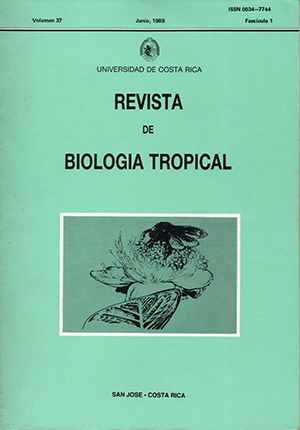Abstract
Quercus costaricensis Liebm, growing near Cerro de la Muerte, Cartago Province, Costa Rica has been found to produce 42% multi-seeded acorns. With the addition of Q. costaricensis there are now 10 species of Quercus known to produce acorns that contain more than one seed. The only published explanation suggests that insect seed predation may be the selective agents producing an advantage to trees that make multi-seeded acorns period. Q. costaricensis was found to experience little insect predation, forcing us to generate an alternative explanation for the multi-seeded acorn habit of some oaks. We hypothesize that the production of multi-seeded acorns is selectively neutral, being found only in oaks that produce a wide range of seed weights even within the single seeded acorns they produce. Abnormalities in cotyledon number within acorns are also noted.
References
Buchholtz, J.T. 1941. Multi-seeded acorns. Trans. Illinois State Academy of Science 34:99-101.
Burda, R.I. & F.L. Schepotiev. 1973. Spontaneous polyploidy in seedlings of multi-seeded acorns of Quercus robur L. Tsitologiya I Genetika 7: 140-143.
Burger, W.C. 1983. Quercus costaricensis (Encino, Roble, Oak), p. 318-319 In D.H. Janzen (cd.). Costa Rican Natural History. University of Chicago Press, Chicago.
Coker, W.C. 1904. Multi-seeded acorns. Bot. Gaz. 37:61-62.
Coker, W.C. 1912. The seedlings of the live oak and the white oak. J. Elisha Mitchell Sci. Soc. 28:34-41.
Garrison, W.J. & C. K. Augsurger, 1983. Double and single-seeded acorns of bur oak (Quercus macrocarpa): frequency and some ecological consequences. Bull. Torrey Bot. Club 110:154-160.
Gould, S. J & E. S. Vrba. 1982. "Exaptation- a missing" term in the science of form. Paleobiology 8: 4-15.
Harvey. L.H. 1917. Polyembryony in Quercus. Mich. Acad. Sci. Rept. 19:329-331.
Hosner, J.F. 1959. Multi-seeded acorns. J. For. 57: 127.
Janzen, D.H. 1983. Insects, p.619-645 In D.H. Janzen (ed.). Costa Rican Natural History. University of Chicago Press, Chicago.
Meehan, T. 1871. Communication reported in Proc. Acad. Nat. Sci. Philadelphia 23:155-156.
Mogensen, H. L. 1975. Ovule abortion in Quercus (Fagaceae). Amer. J. Bot. 62: 160-165.
Rehder, A. 1949. Manual of cultivated trees and shrubs hardy in North America, exclusive of the subtropical and warmer temperate regions. Macmillian Co., New York. N.Y.
Reines, M. 1969. Anomalies in acorns of Quercus acutissima Carruthers. Bull. Georgia Acad. Sci. 27:141-143.
Sargent, C.S. 1905. Manual of the trees of North America (exclusive of Mexico). Houghton Mifflin Co., New York, N.Y.
Smith, C.P. 1914. Plurality of seeds in acorns of Quercus primus. Rhodora 16: 41-42.
Sudworth, G.B. 1927. Checklist of the forest trees of the United States, their names and ranges. USDA. Miscellaneous Circular 92.
##plugins.facebook.comentarios##

This work is licensed under a Creative Commons Attribution 4.0 International License.
Copyright (c) 1989 Revista de Biología Tropical


